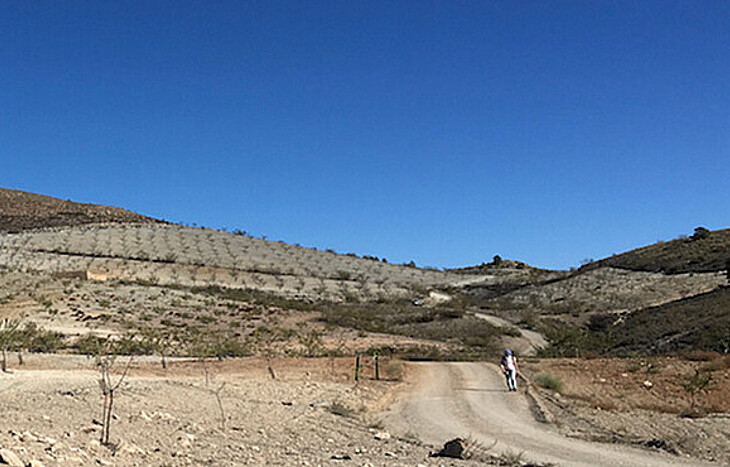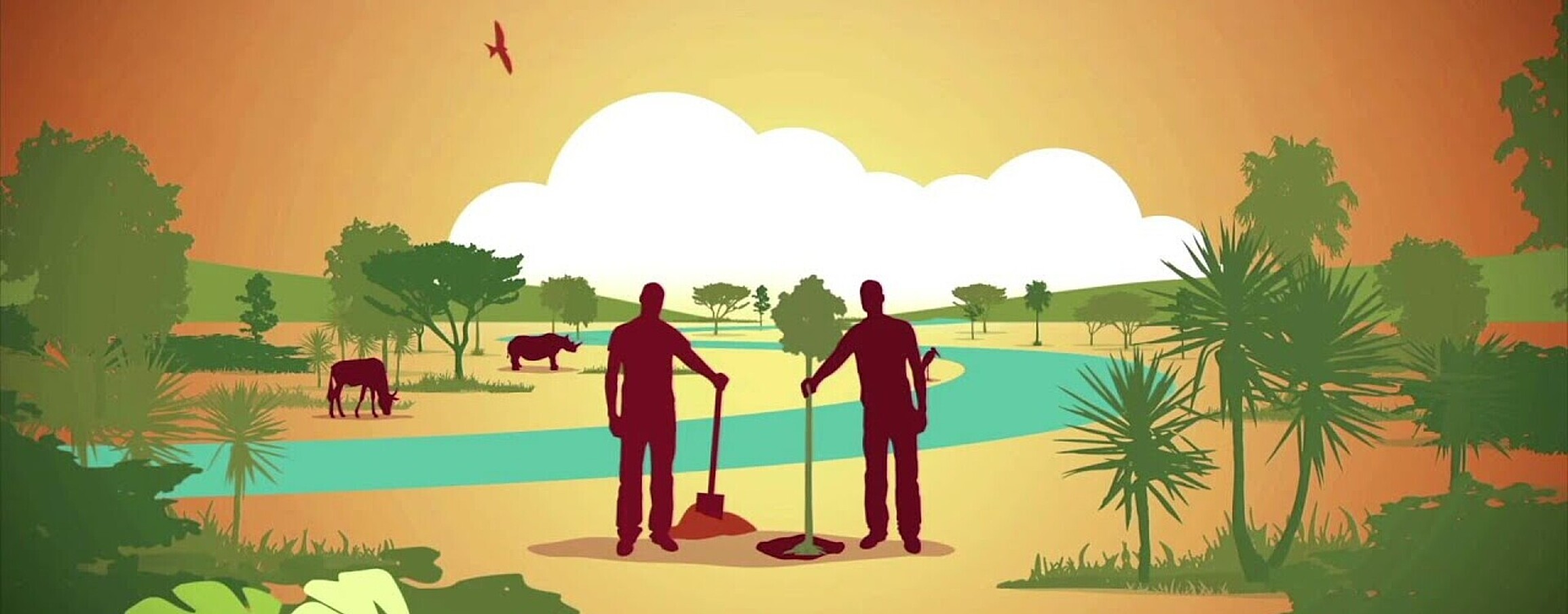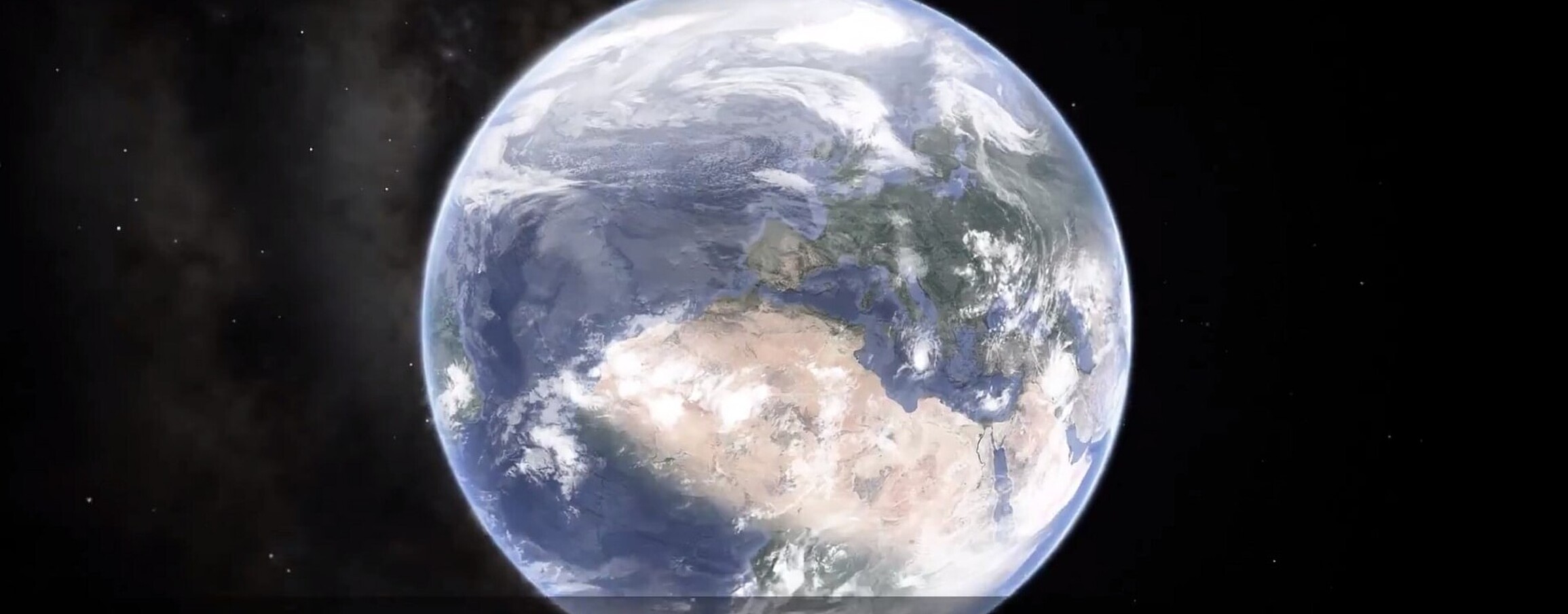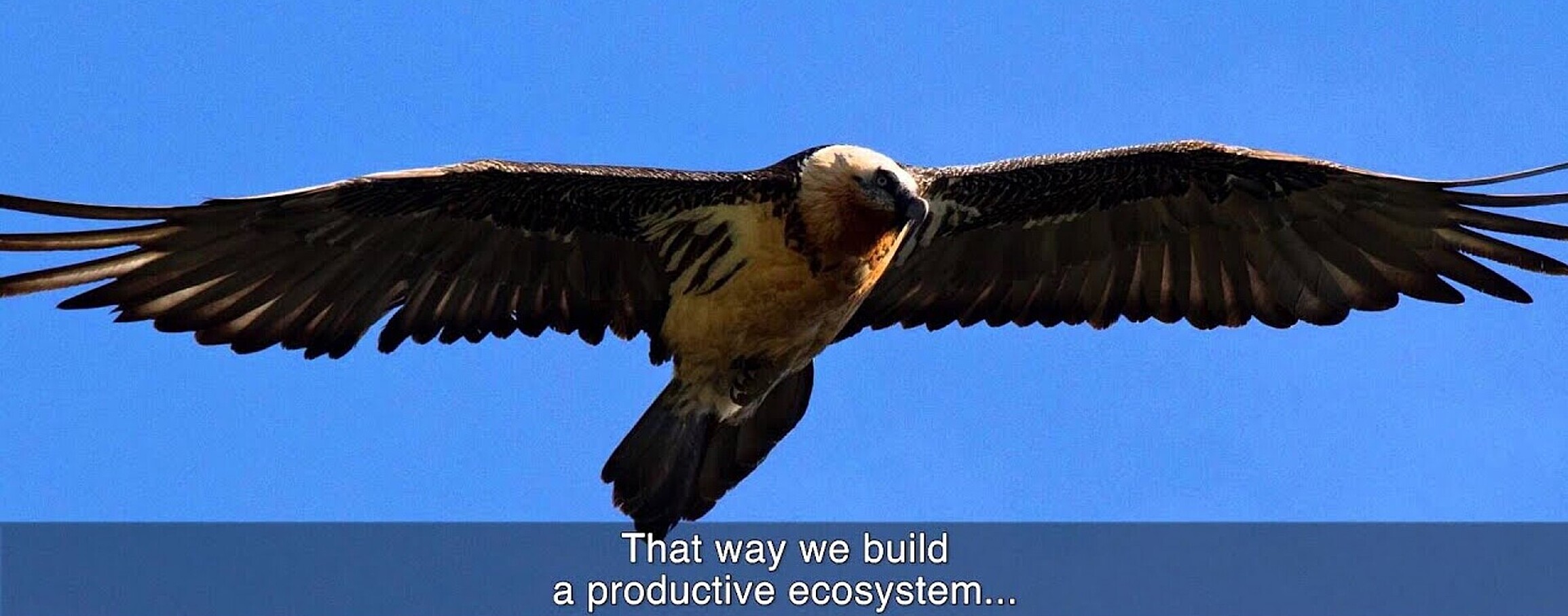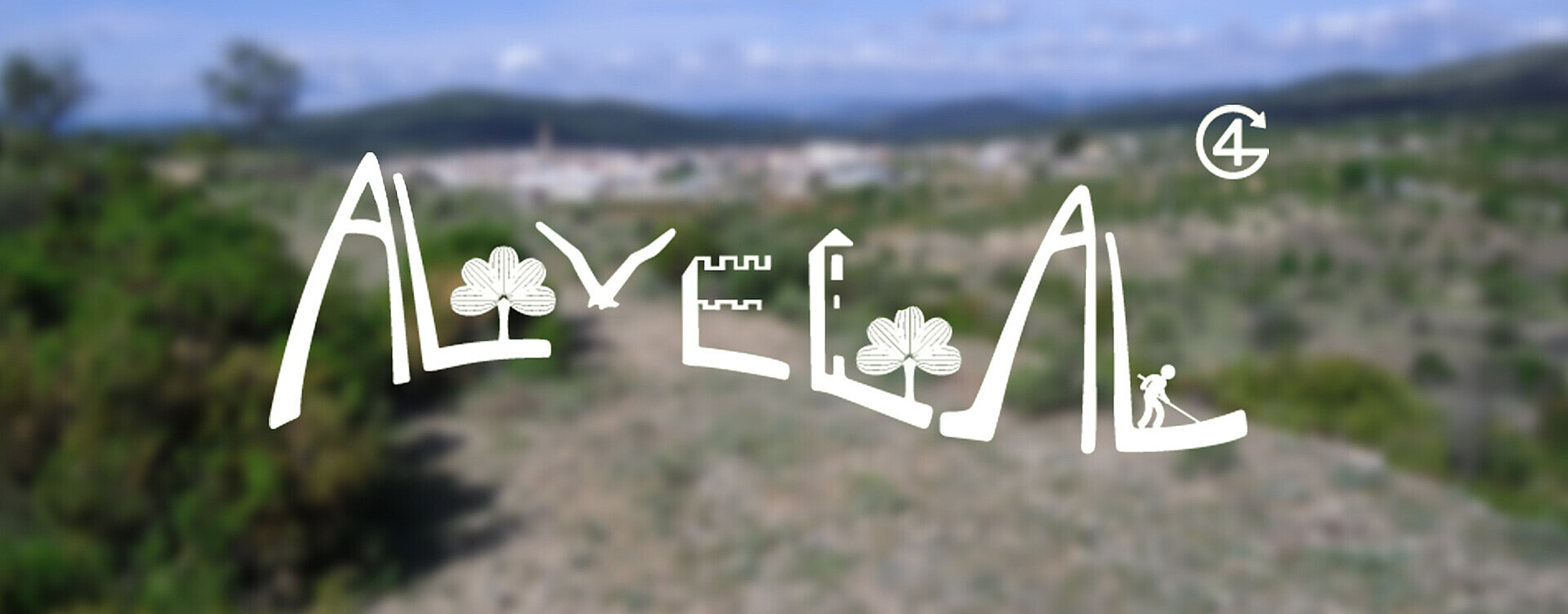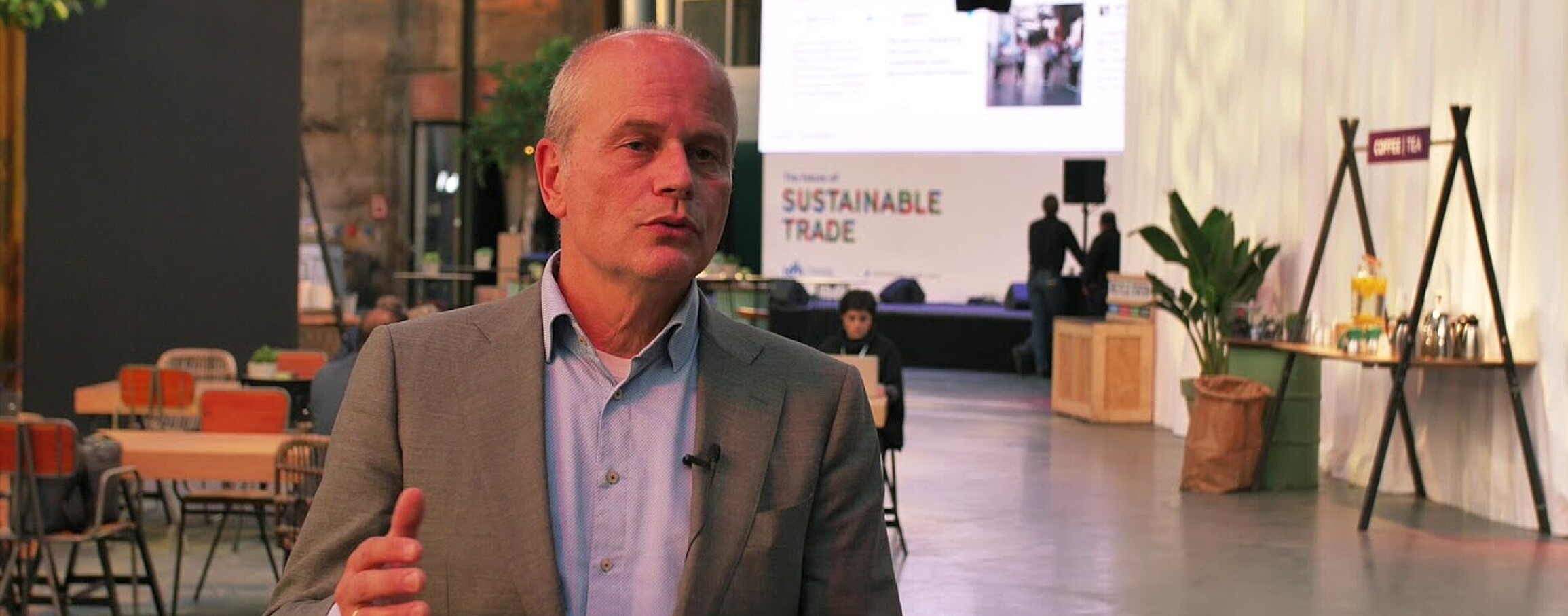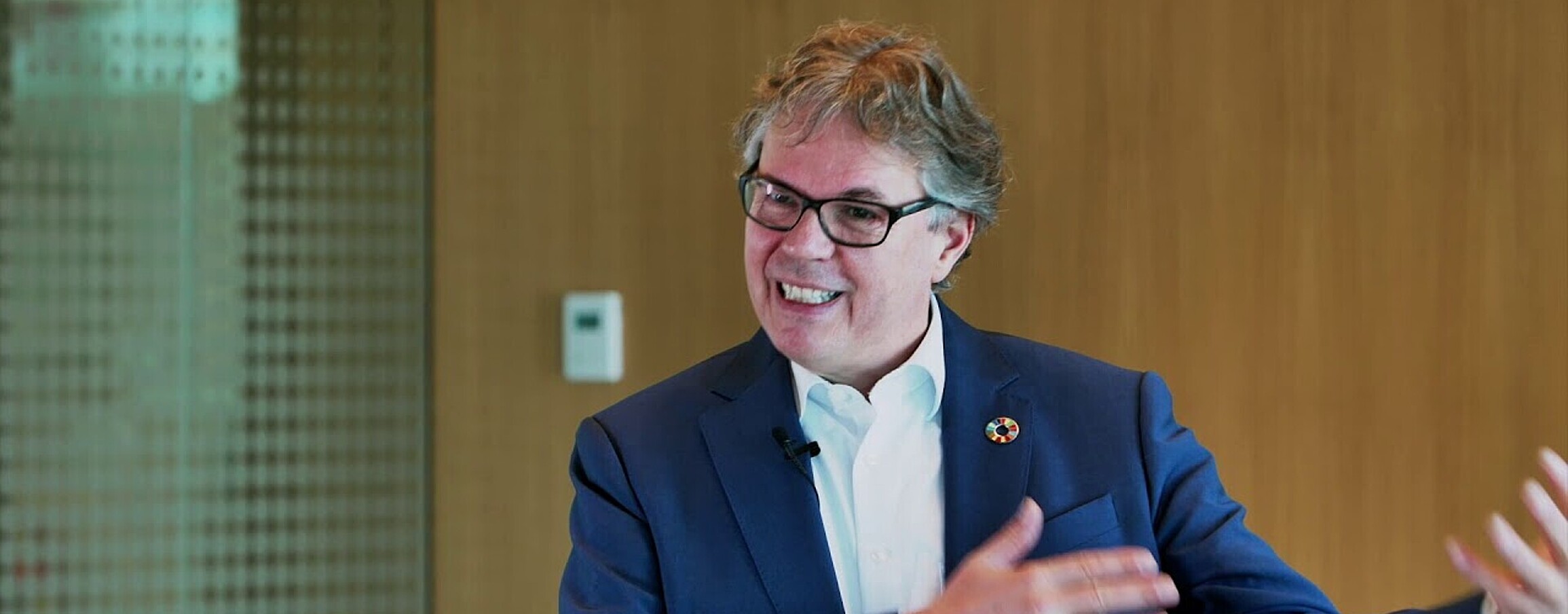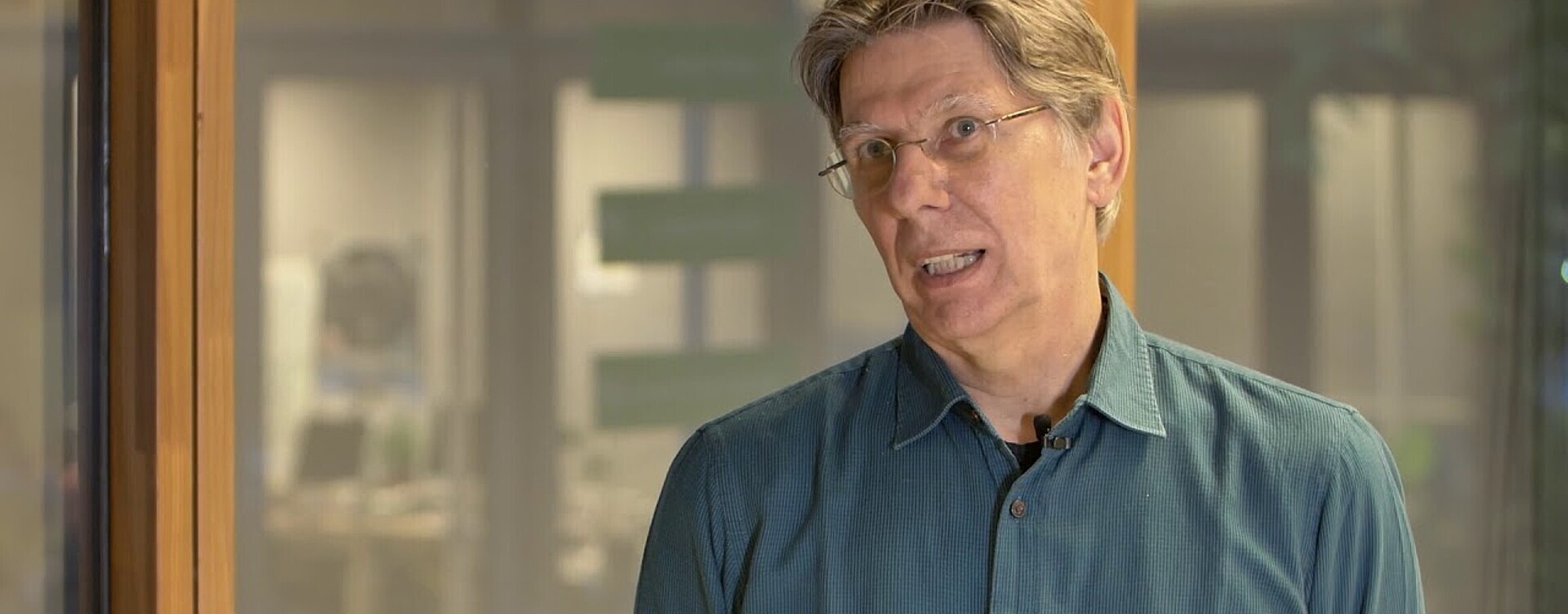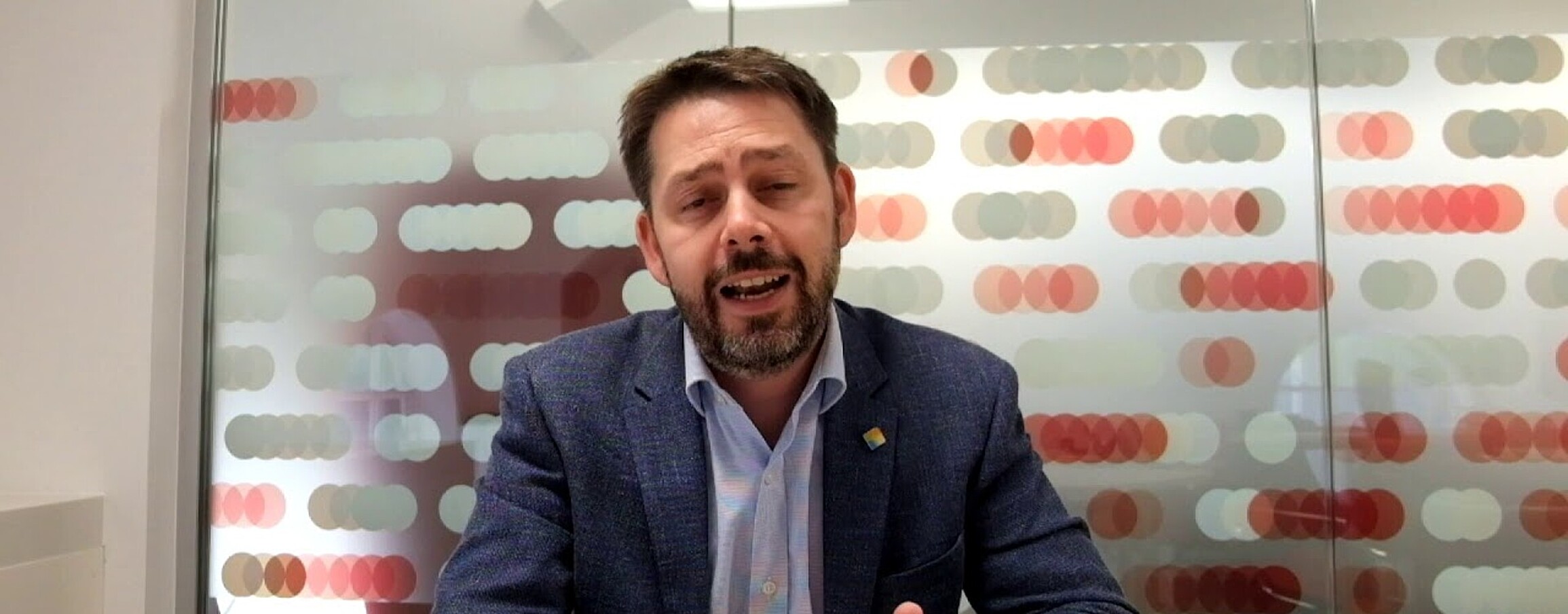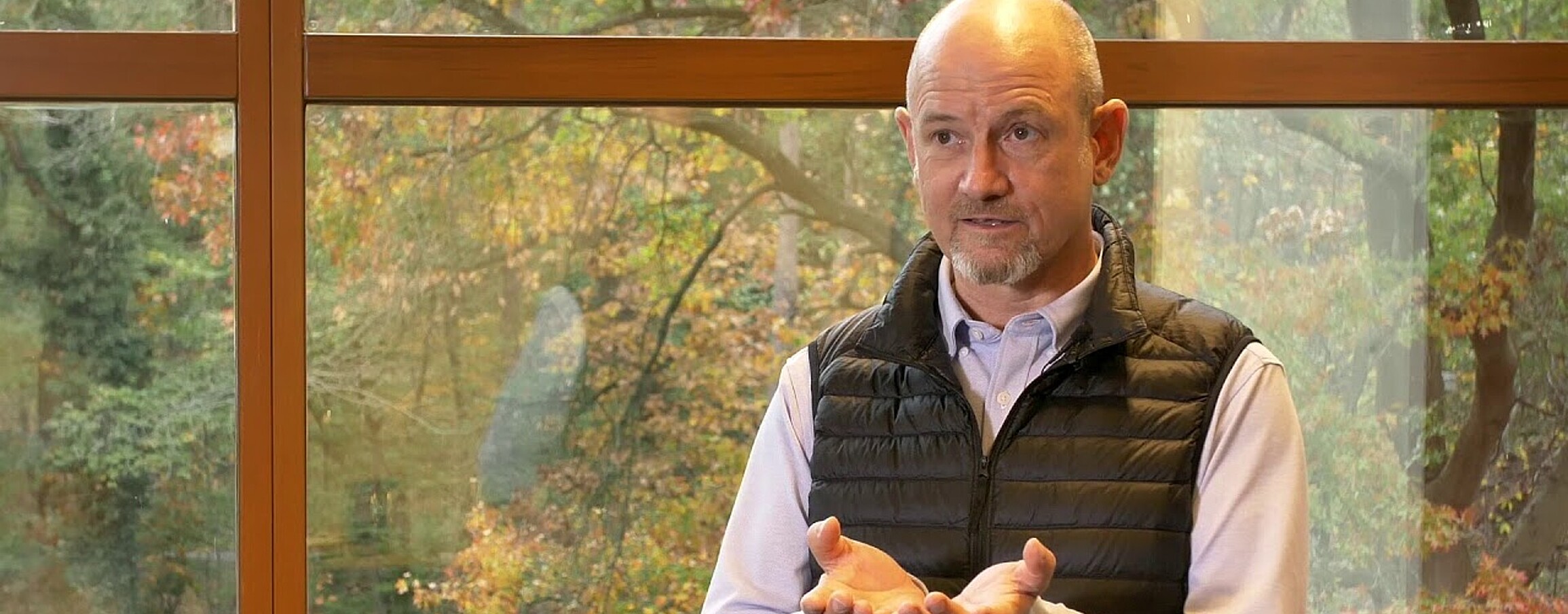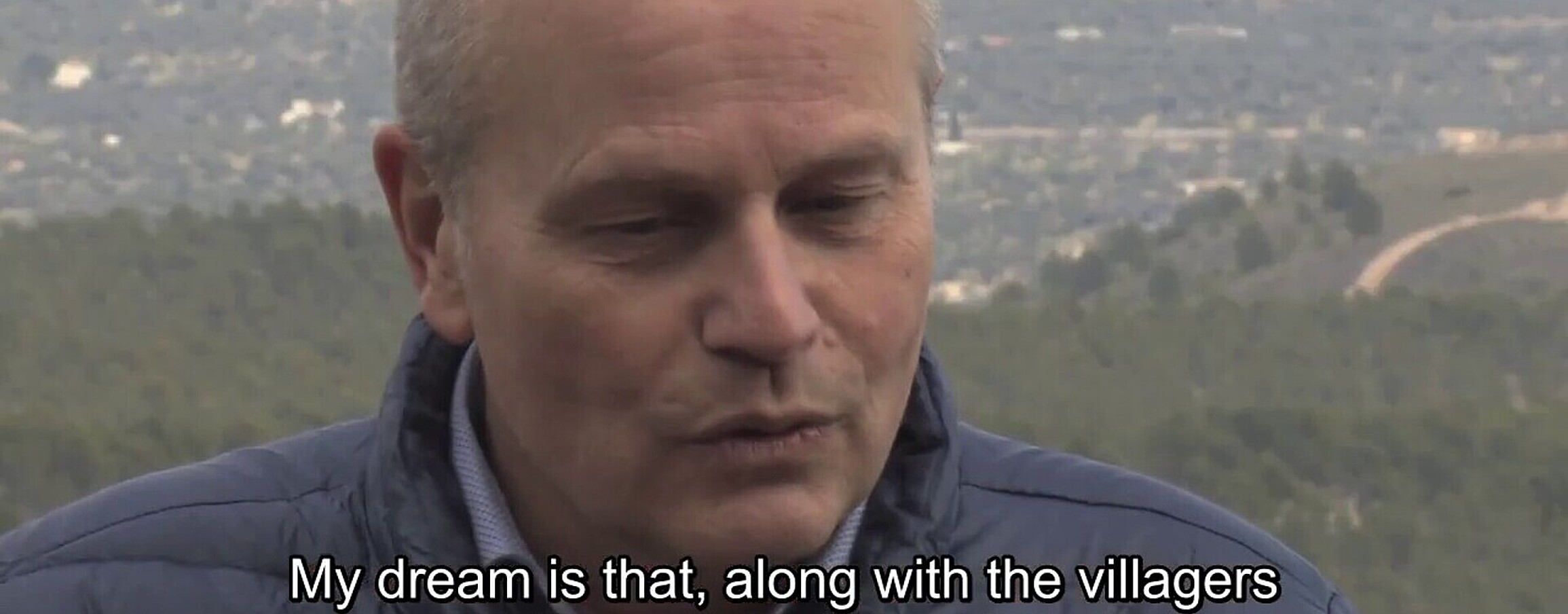Commonland has the ambition to restore 100 million hectares of degraded land worldwide by 2040 – 5% of the 2 billion hectares of degraded land on the planet. Altiplano Estepario in Southern Spain, that encompasses 1 million hectares, is one of its successful restoration initiatives. However, in order to scale up the existing projects in Spain, and in other parts of the world, Commonland first needs to convince local farmers that it is financially attractive for them to switch from conventional farming to sustainable farming combined with reforestation. Only after having the farmers’ financials analysed, can Commonland approach public and private investors with a concrete proposal for long-term funding. What should the financials for the farmers look like? What proposal can Commonland make to investors?
Global Context
Approximately a quarter of the Earth’s land mass is seriously degraded from centuries of overgrazing, monoculture, deforestation, extractive industry, urban infrastructure, and over exploitation. An estimated of 7.3 million hectares of forests are lost each year, according to the United Nations' Food and Agriculture Organization (FAO). This has led to a reduction of the land’s capacity to provide ecosystem services.
There are two billion hectares of degraded land with the potential to be restored in the world today. From this amount, 1.5 billion hectares are suitable for mosaic landscape restoration, in which trees and forests are combined with other land uses including agroforestry. These integrated systems represent a huge opportunity for ecosystems’ recovery, communities’ development, and businesses creation, and therefore positively impact the societies built upon them.
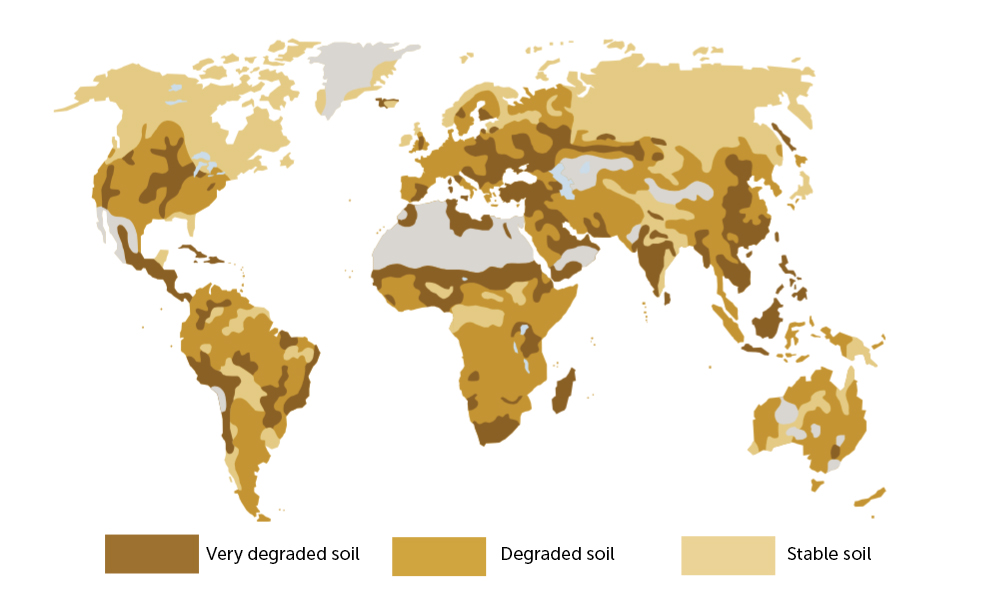
“We see a world in which we can live in harmony with ourselves, each other and our landscapes. To achieve this, we help turn degraded landscapes into thriving ecosystems and communities. There are 2 billion hectares of degraded land with the potential to be restored in the world. By 2040, we aim to create 100 million hectares of thriving ecosystems and communities.”
– Commonland (www.commonland.com).
Background
The nongovernmental organization Commonland was founded in 2013 with the mission to turn degraded landscapes into thriving ecosystems and communities.
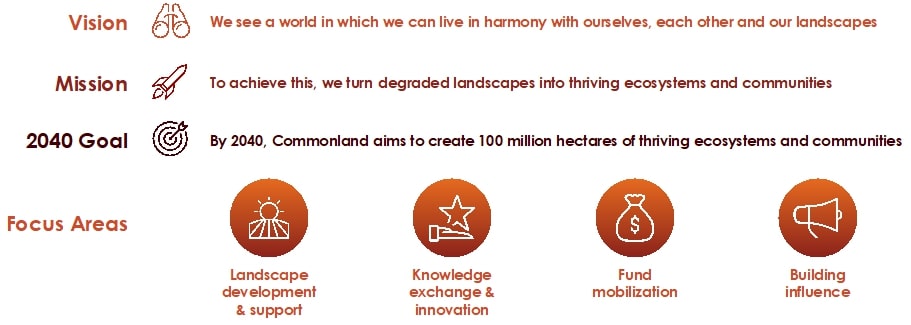
Commonland was established through a joint effort of three organizations: The Commission on Ecosystem Management at the International Union for Conservation of Nature (IUCN), the Rotterdam School of Management (RSM), and the COmON Foundation.
The way Commonland works is supporting farmers’ initiatives and co-establishing companies with local stakeholders. Together with its regional partners, Commonland has initiated four large projects around the world by 2019: Baviaanskloof-Langkloof in South Africa (550,000 ha); Altiplano Estepario in Andalusia, Spain (1,000,000 ha); the Western Australian Wheatbelt in Australia (300,000 ha); and the Western Peat Meadows in The Netherlands (125,000 ha).
Through partnering with third parties, Commonland also shares its lessons with those who wish to implement long-term local restoration projects and scale them globally. In 2018, Commonland engaged in partnerships in seven countries apart from the Netherlands, including Haiti, Colombia, Egypt, Zambia, Kenya, Tanzania, and Congo.
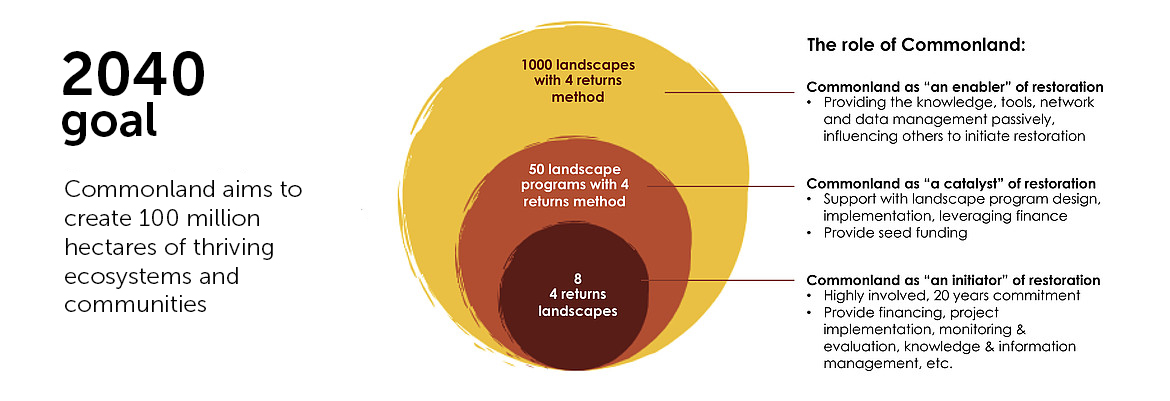
4 Returns
At the core of every restoration initiative of Commonland lays the aim to work closely with local farmers, land-users and experts, ensuring that every project had the potential to develop a viable business case as the basis for its practices. In order to do that, Commonland has developed a 4-return, 3-zone, 20-year framework.
The 4 returns expected from the restored landscapes are:
- Inspiration: give people hope and a sense of purpose.
- Social capital: employment, business activity, education, and security.
- Natural capital: biodiversity, water and soil quality improvement.
- Financial capital: long-term sustainable profits.
In every landscape 3 geographic zone are distinguished, each with a different balance between economic activity and undisturbed nature:
- The first zone is the natural zone, where most nature is untouched. The objective here is to fully conserve and restore the ecosystem so that it can provide all the services it has the potential to provide: rich biodiversity, carbon sequestration, water regulation, and forest products.
- The second zone is a combined zone, with the objective to restore the topsoil and deliver low and sustainable economic productivity. Ecosystems are restored to provide biodiversity and carbon sequestration, but in this area agroforestry, fruit and timber production and tourism activities also take place.
- The third zone is the economic zone, designed to deliver high and sustainable economic productivity. Here crops are sustainably grown and harvested, and infrastructure and real estate development take place.
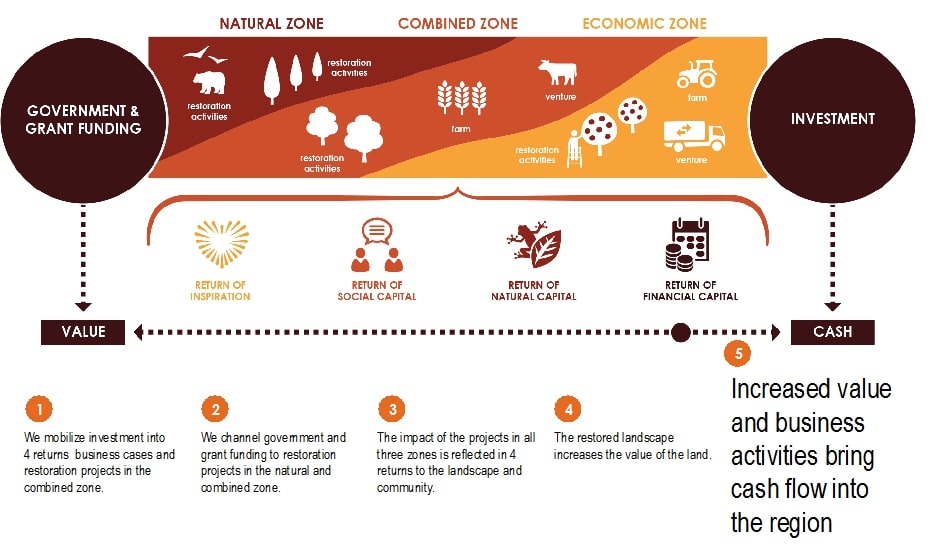
“We focused on Spain because the Mediterranean is badly affected [by erosion] and there were already UN reports of progressing deforestation in 2009. We were looking for a high plateau that people wanted transformed, and now we have the biggest land-restoration program in Europe.” - Willem Ferwerda, Commonland CEO.
Overview
The Altiplano Estepario (translated as “high plateau steppe”) is located in Andalusia and Murcia in Southern Spain. This depopulated countryside is home to 250,000 inhabitants in 2018 and is one of the poorest and driest zones of Spain. The area was affected by 40% unemployment rate, monocropping, deforestation, and agricultural subsidy dependency, but also comprises thousands of hectares of natural parks, rich biodiversity and cultural history.
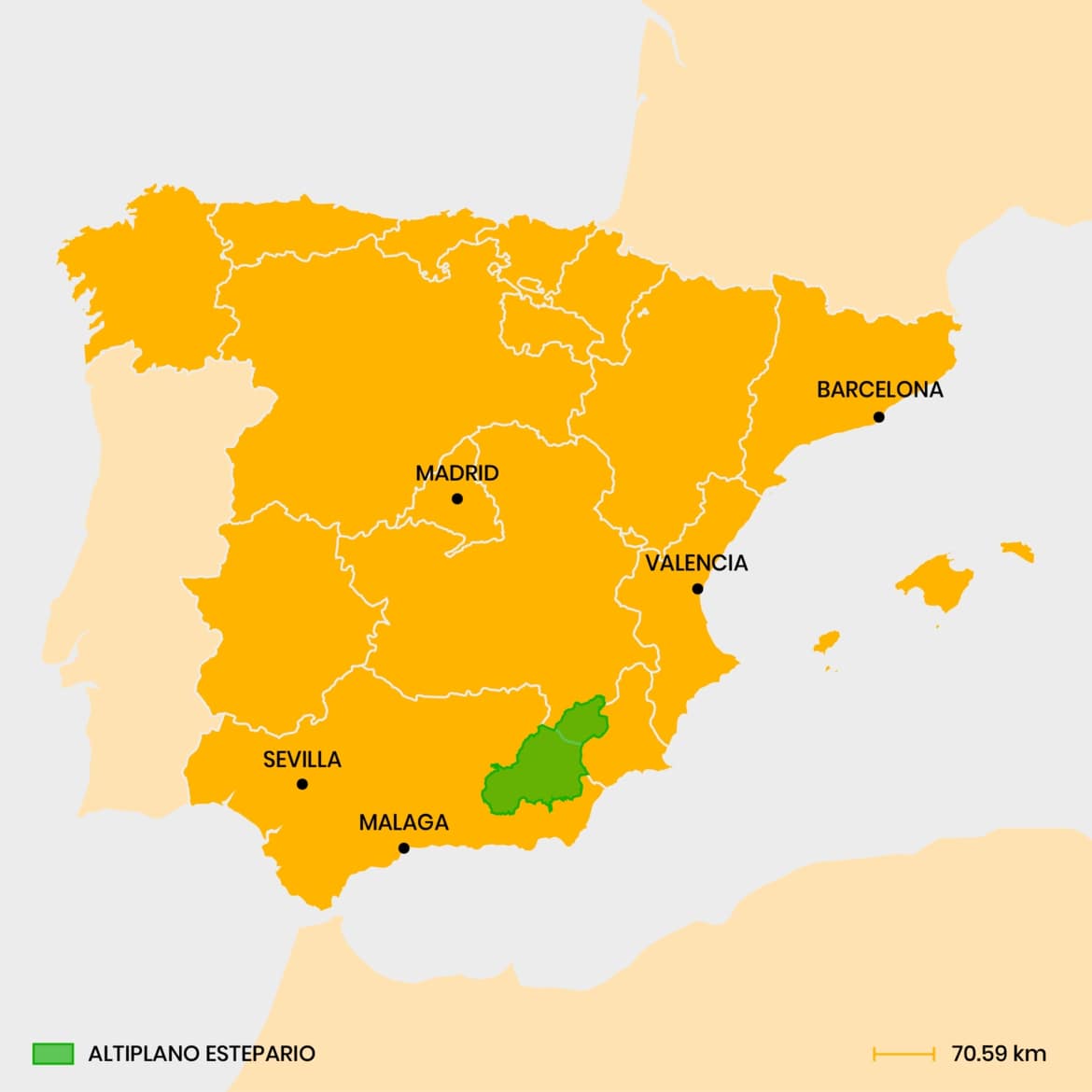
The Altiplano does not consist of one general landscape, but of many specific landscapes where everything is intertwined – desert, greener areas, wetlands along the rivers, trees on the mountain slopes, and populated zones. Forested areas are typically located on the mountain slopes, where productive activity is not possible due to the gradient or the rocky soil.
Land is both public and private. It was important for Commonland to engage and align with local governments, natural park authorities as well as private landowners.
In 2014 Commonland initiated the movement AlVelAl to implement regenerative agriculture at scale, to create the demand for regenerative produce and to restore natural zones on farms and on public land.
After four years of combined effort and continued commitment from all stakeholders, the initiative grew to what it was in 2018: 85 farmers actively working with sustainable and regenerative practices on 7,700 hectares of land; 12 direct and 30 indirect jobs created; and 4 business cases identified (almonds, olive oil, compost, and tourism).
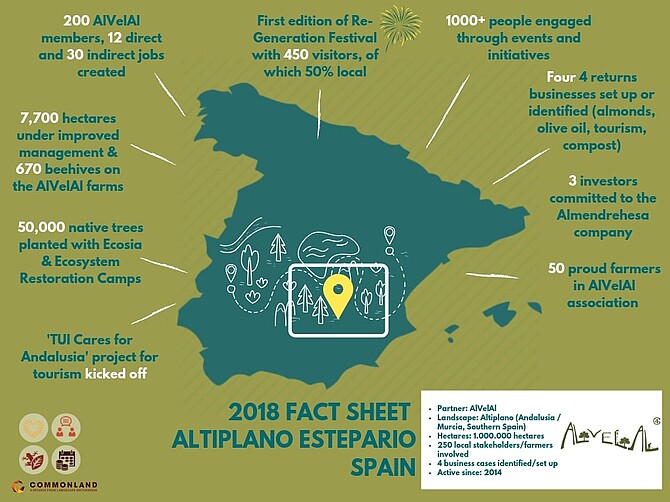
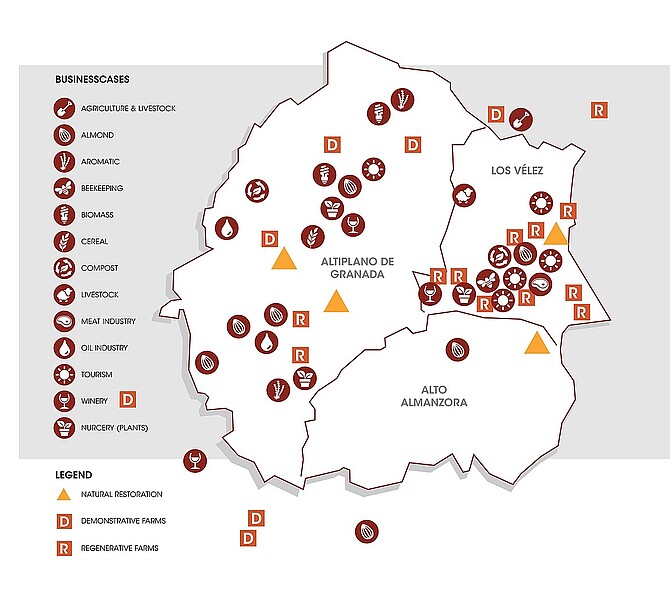
Projects
The main projects running in 2018 include:
- Restoration of mountain La Muela in the natural park Sierra María Los Vélez with 50,000 trees planted of oaks, juniper, and Aleppo pine species;
- Many farms on the journey towards regenerative farming, where AlVelAl is providing technical advice, workshops and enables pilot projects;
- Commercialization of high-quality almonds produced by La Almendrehesa (86 tons purchased and commercialised in 2018);
- The touristic project “Destination Alvelal” to promote regenerative agriculture and to develop the supply and value chain of regenerative produce towards touristic centers on the Spanish coast in collaboration with TUI Care Foundation;
- The project ‘AlVelAl 8000: Sculptures with life’ to restore public land with aromatic herbs in the shape of the famous 8,000 years old cave painting that are iconic for the region.
Embeded in these projects are 4 successful business cases:
The Almendrehesa
La Almendrehesa is Alvelal’s first 4-returns business case. Based on the business case, a farmer-driven trading company of the same name was founded in 2016 to process and market produce from the almendrehesa ecosystem*, firstly focusing on almonds, later on adding other produce such as wine, cereals, honey, aromatic herbs, olives and segureño lamb. All of these are produced by farmers of the Altiplano by applying regenerative agriculture practices. By 2019 the company had 21 shareholder farmers and 8 partnering farmers cultivating 1600 hectares of almond orchards.
* The almendrehesa ecosystem is an integrated production system: combining almond and endemic trees, with aromatic herbs, cereals, grapes, active bee hiving and lamb farming. Such an ecosystem increases its resilience, decreases erosion, restores the water balance, enhances biodiversity and beautifies the landscape.
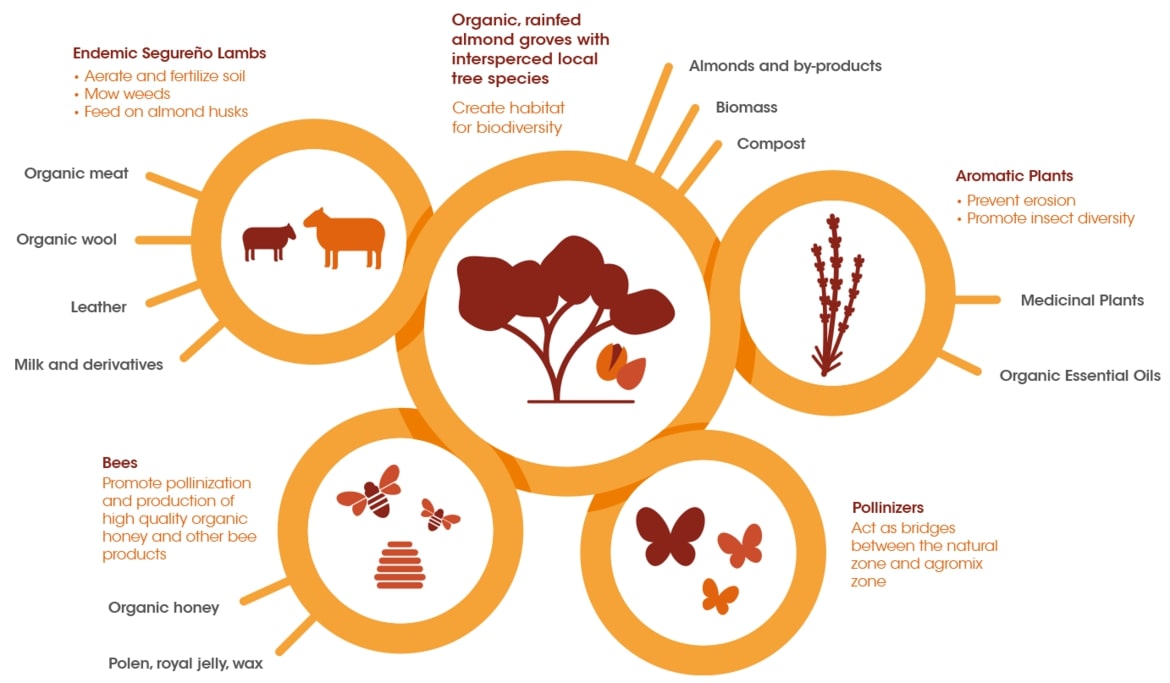
The business strategy of La Almendrehesa is two-fold: it offers farmers a higher price for their produce, enabling them to invest in their farms; it also offers clients a high-quality product, which is not only produced following organic principles but actually contributes to landscape restoration.
Almonds produced by La Almendrehesa farmers are sold in both retail and wholesale markets. Premium quality, big size almonds are marketed under the retail brand “Pepita de Oro” (golden seed) primarily in Spain, but also in other countries such as Germany and the UK. The package of Pepita de Oro is made from agricultural waste and renewable resources and 100% compostable. Smaller almonds enter the wholesale market internationally as diversified products such as roasted almonds, almond oil and press cake meal.
La Almendrehesa hopes to scale up its regenerative almond turnover from 86 tons in 2018 to 168 tons in 2021, and to 1,000 tons in 2036, which is equivalent to an increase of regenerative almond farming areas from 1,600 hectares in 2018 to 6,000 hectares in 2021 and 24,000 hectares in 2036.
The company is in contact with important market players to distribute its product nationally as well as internationally. It has also attracted some impact investment capital to expand infrastructure, diversify products, set up marketing, and continue restoring the landscape of the Altiplano.
Restoration of Mountain La Solana de La Muela, Murcia
La Muela is an iconic mountain in Spain. Commonland has restored 400 hectares of land and taken actions to stop erosion and degradation. On steep slopes where water infiltration is difficult, it focuses on water retention and reforestation of endemic species. In the lower region, it has started an innovative project to make aromatic products; the aerial view of the aromatic fields resembles local ancient rock art.
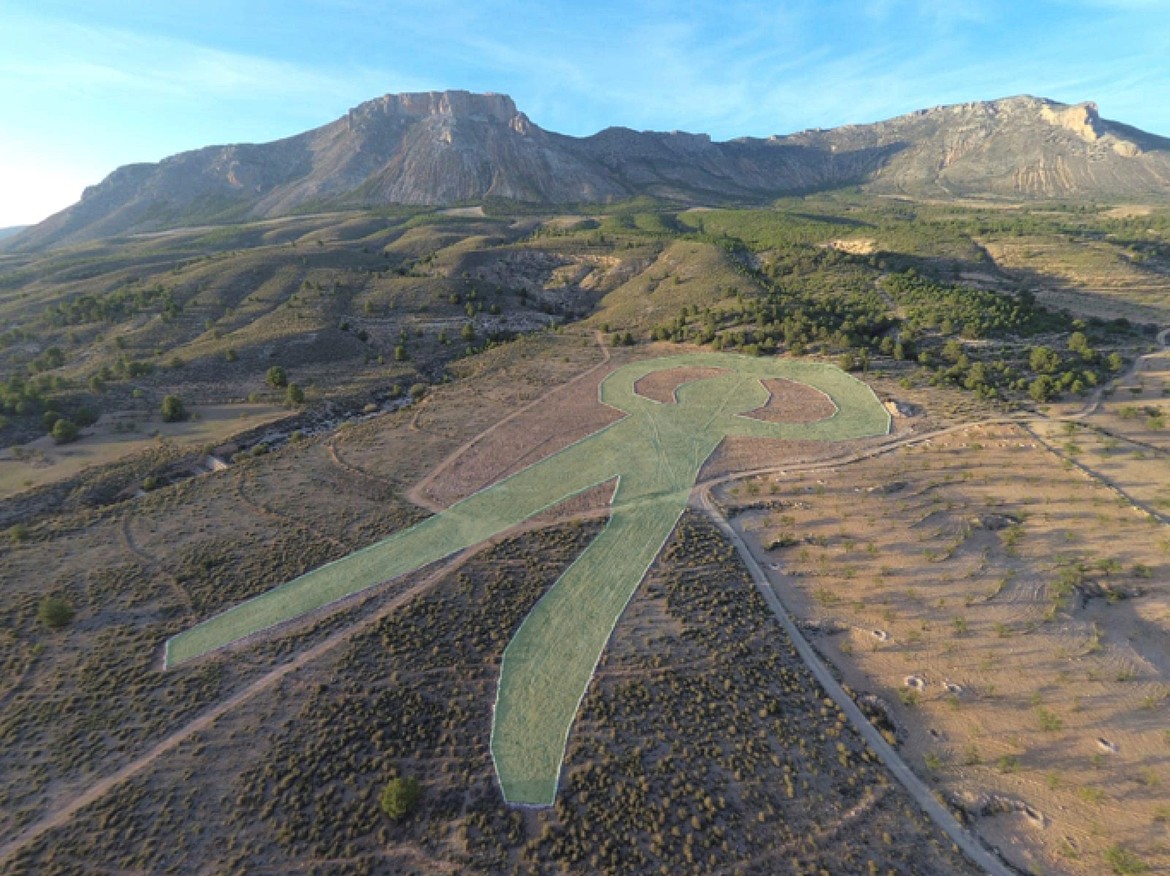
Organic farm La Junquera and the Regenerative Academy in Murcia

La Junquera is AlVelAl’s largest farm. Owned by Madrid native Alfonso Chico de Guzmán since 2012, the farm consists of 1100 hectares located 70 km west of Murcia, the city that gives its name to the whole province. Characteristics of this region are the semi-arid climate, the very low precipitation, the mountainous terrain with an average of 1000 meters high, and the sparse population. The agriculture in the province is based on cereals, rainfed almonds, olives and the local ‘Segureño’ sheep breed.
Experiencing the serious erosion and desertification problems of southern Spain (desertification threatens 75% of Spanish territory and 90% of Murcia province), Chico de Guzmán has been implementing farming techniques adapted to climate change, erosion, and the extreme dry conditions of Murcia. By introducing “regenerative” practices such as building silt traps and ponds, limiting tilling, carving swales to collect rainwater and sediment traps to catch nutrient-rich topsoil, he is trying to restore the soil’s health, hold back the advancement of the desert, and bring back life to La Junquera village. "This farm has been in my family for five generations… But climate change is affecting this area quite fast. Part of the soil was very badly eroded. We were hitting bedrock when we were digging under the topsoil," recalls Alfonso, who says soil loss in his farm reaches 40 to 50 metric tons per hectare per year, about the double of the region’s average.
La Junquera has been slowly transformed into a beacon of regenerative agriculture in southern Spain according to the 4 returns principles of Commonland. The main organic commercial crops in the farm are cereals (500 ha) and almonds (300 ha). There is also production of pistachio (6 ha), walnuts, apples, cherries, grapevines and vegetables. About 300 hectares have diverse natural zones, some of them steep, rocky, densely forested, bare or degraded.
*All figures are till March 2019.
The Regeneration Academy

In the centre of La Junquera is the Regeneration Academy, a young organization created with the aim to offer “a transdisciplinary learning environment for those people and organizations who want to co-create the future of farming and food.”
For the academy, regenerative agriculture and land use is an essential part of its future food system. The academy works with young professionals, students and entrepreneurs, rural communities, universities, institutes and organizations connected to regenerative agriculture and ecosystem restoration.
The farm and the academy coexist in symbioses: the farm facilitates land and infrastructure, while the Regeneration Academy helps the farm make better decisions on restoring landscape, biodiversity and sustainable profit. “Conventional farming practices are causing many problems in the region which is already one of the poorer regions in Europe. On a farm level, this means soil erosion and decreasing fertility, decline of biodiversity, lack of water (both drinking and farm use). On community level, this means rural abandonment because of lack of possibilities, greying, outmigration, and a lack of inspiration among young people… Regenerative practices not only help to reduce erosion, improve fertility and increase water infiltration, but also increase dramatically the biodiversity,” says the academy.
Scaling and Financing
Commonland is very hopeful about La Almendrehesa, its first business case in Spain, and wants to replicate the model with almonds and other regenerative crops such as olive oil, wine and honey in the whole area of the Altiplano. In this way, its landscape restoration initiative in Spain can reach more scale and become more interesting for investors of different kinds.
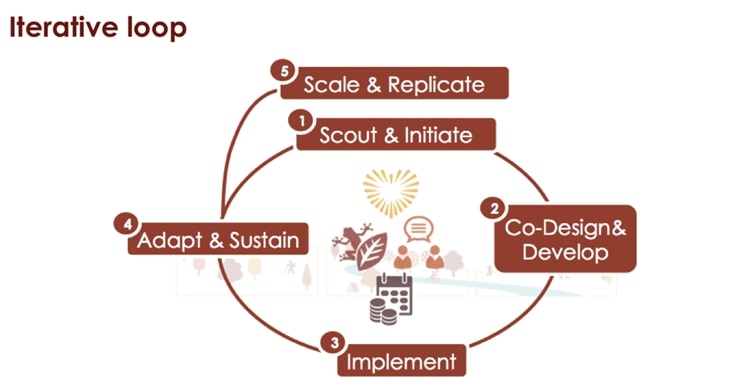
There are many types of investors out there besides NGOs and philanthropists who are willing to support sustainable landscape restoration initiatives, such as banks, asset management firms, and private funds, and the number is growing.
Already in 2017, Rabobank and the UN Environment announced the creation of a 1-billion-dollar facility to finance sustainable agriculture using a combination of public and private funding. There are already a few examples of landscape restoration initiatives, where investors, businesses, and land users overcame barriers and created commercially viable projects. These examples show how different investment instruments, such as blended finance, green bonds, and asset class, could offer large amounts of public and private capital options for sustainable land use management at scale.
How can these apparently different worlds of large finance facilities and relatively small business investment opportunities meet in Spain? This is the central question for Commonland.
Large-scale landscape restoration projects usually need four layers of continued financing:
- Initial grants (less than one per cent) to mobilize people;
- Subsidies to get the action on the ground started the first (and subsequent) year(s);
- Private and public investment after 5 years to scale up the first investments;
- Private and public investments for the long-term run of the whole project.
Commonland bases its funding model on these four layers and is aiming to use blended finance mechanisms to fund the scaling of its initiative in Spain. Different types of investors with different expectations and goals could together reduce the risk of investment.
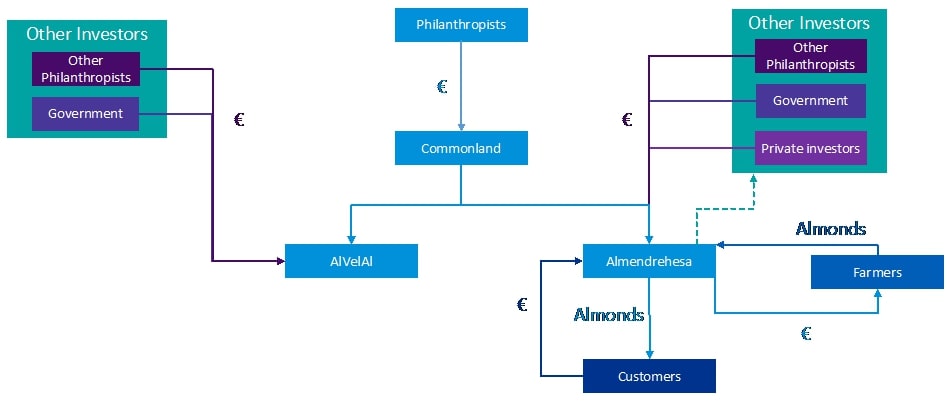

“Sustainable finance looks at how finance (investing and lending) interacts with environmental, social and corporate governance factors and thus has the potential to move from finance as a goal (profit maximization) to finance as a means to a greater good, serving the society and its citizens, and tackling environmental challenges… Finance is about anticipating catastrophic events and incorporating expectations in today’s valuations for investment decisions.” - Dirk Schoenmaker and Willem Schramade, authors of Principles of Sustainable Finance.
According to Paul Chatterton, founder and lead of WWF Landscape Financial Lab, there are approximately 1,000 places in the world that need urgent sustainable management, but most problems of poverty, emissions and biodiversity loss occur only in 100 of them. If we can fix these problems in the next 10 years, the environment and the communities around the world will have benefited greatly. Each of this landscape restorations cost less than an aircraft carrier, so it is doable.
Today, there are many different worldwide initiatives to restore degraded landscapes. For example, the Bonn Challenge aims to bring 150 million hectares into restoration by 2020, and 350 million hectares by 2030. The United Nations General Assembly declared 2021–2030 the UN Decade on Ecosystem Restoration. The New York declaration on Forests strive to halve deforestation by 2020 and to end it by 2030.
To restore this much of deforested and degraded land would require about 350 billion dollars each year, but the capital pledged so far is only 51 billion dollars a year, making a shortfall of 300 billion. This has created huge opportunities for mainstream investors looking to put their money in rewarding and sustainable projects.
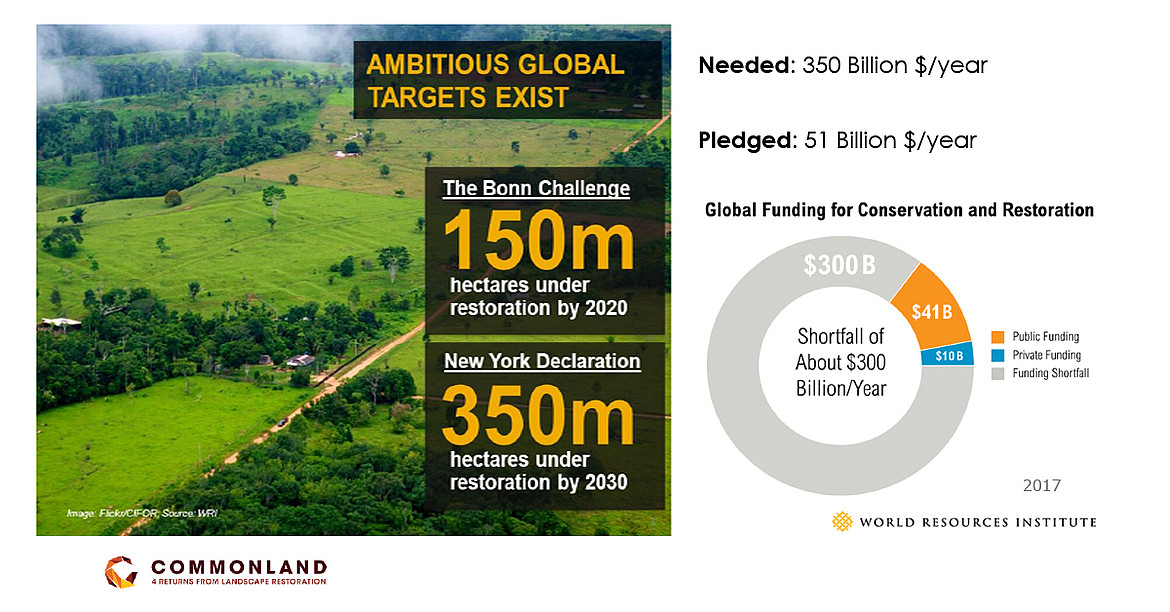
The World Resources Institute lists the following major barriersto invest in large scale land restoration:
- The environmental and social benefits often have no market value;
- Incentives to degrade land outweigh incentives to restore land;
- It is difficult to access climate finance;
- Restoration funding is often confined to small environmental budgets;
- Many restoration projects are too small in size to attract private finance;
- Restoration often requires a long investment time horizon (10–20 years);
- Restoration is considered to be a risky investment.
“We would need size, a minimum capital we can deploy. It can be 100 or 200 million. And the right risk returns. For high risks, a return that is commensurate to that risk. Since we don’t have the expertise ourselves in land restoration, we would need somebody to do that for us. Somebody who knows the operations, but also who knows the financials, that is able to speak to institutional investors and who has track record, who has done this before, experienced in setting up a vehicle for an investor, who knows how to report to us. We want to know the experts in the subject matter…”– Jos Lemmens, senior portfolio manager of natural resources at APG Asset Management.

To engage institutional investors in landscape restoration, reducing financial risks is vital. To minimize the risks, an organization has to get stable projections of the future ecosystem services outcomes, and thus, to get stable projections of the cash flows in time.
Blended finance can be an instructive tool here. According to the World Economic Forum, blended finance uses public or philanthropic money to improve the risk-return profile or commercial viability for a private investor, allowing it to invest in places and projects where it wouldn’t otherwise go, by mitigating a raft of real or perceived barriers, including political risk, currency volatility, lack of liquidity, weak local financial markets, knowledge gaps about investment opportunities, and challenging investment climates, including poor regulatory and legal frameworks.
The first step to deploy blended finance is to determine the risk of a project. A high risk will decrease the Net Present Value (NPV) of ecological services in time.
The second step is to allocate the cash flows to the various stakeholders. Local government would, for example, benefit from the social capital generated by the project and may thus be interested in co-investing in the project. For the environmental capital, one should look to all stakeholders. Both private and public parties benefit from land restoration through ecological services in different forms (e.g. higher crop prices, improved water management, more tourism).

In order to convince investors to put money in Spain, Commonland would need to begin with monetizing the tangible as well as the intangible values of landscape restoration in the Altiplano. The best way to approach this is to recognize integrated value (the total sum of financial, social and environmental capitals), include it in the cash flows, and adjust it by risks in time.
What would it mean for farmers financially if they converted to sustainable and regenerative agricultural practices?
The Commonland team has made some initial calculations of cash flows at the farmer’s level (see Spreadsheet), basing their assumptions on an average farm that follows the La Almendrehesa regenerative agricultural concept and delivers produce to the Almendrehesa trading company.
The typical farm has 50 hectares of land, 70% of which is used for farming and the rest is forest. The operating period is 30 years with the first 5 years as the initial investment period. In this initial period, the farmer would invest in regenerative farming (both land and trees) but would not see any return until the 6th year.
His/her investments in the first five years would include:
- Trees (almonds): €1,000/ha in Year 0, and another 50% (€500 per ha) in Year 1.
- Other (e.g. land maintenance): €1,000/ha in Year 0, then linearly declining in the next four years (Year 1: 75%; Year 2: 50%; Year 3: 25%).
- From Year 4 onwards, the land would only need labour.
Although investments are concentrated in the first five years, the farmer could anticipate reinvestments down the line because almond trees only live 20-25 years.
Reinvestments would include:
- Trees (almonds): Year 20 at 75% of the Year 0 investment.
- Other: Year 20 at 50% of the Year 0 investment; Year 21 at 50% of the Year 1 investment.
After the first five years of investment period, the farmer could expect gradually increased income from various sources:
- Selling crop: In the first year of harvest (Year 5), the farmer could expect an income of €1000/ha. From Year 6 and onwards he/she could expect an income growth at 4% per annual (depending on weather).
- Markup through Almendrehesa: The assumption is that farmers could sell their organic regenerative almond produce at a premium of 10% higher price than regular organic produce.
- Ecosystem-services (PES: “paying for ecosystem services”): The farmer could receive additional payment of €100/ha/year from selling land access to tour operators (€40/ha/year) and watershed services to municipalities and other governmental organizations (€60/ha/year).
- CO2 certificates: The farmer could capture on average 2 tonne CO2/ha/year on his/her land and issue CO2 certificates for €25 a piece.
During the land restoration period (Year 0-4), the farmer would not generate any income. To offset this, a €25,000 loan would be needed. The investments are funded through additional amounts (see Spreadsheet) and could be structured as below:
- Interest rate: 4% per annum
- Amortisation period: 25 years
- Years 0-5: The farmer would neither pay interest nor amortize the loan.
- Years 6-30: He/she would pay interest on loan outstanding, and linearly amortize the loan.
The farmer would also need reserve 50% of the first year’s total investment as a working capital buffer, packed at an ESCROW account. If needed, the working capital buffer could be used to fill in any financing gaps (due to unpredictable weather and other events) and the remaining working capital could be used to fund the last amortization of the loan (Year 30).
Expert views
Willem Ferwerda, CEO Commonland
Prof. Dirk Schoenmaker, Rotterdam School of Management, Erasmus University
Dr. Rudolf de Groot, Wageningen University
Mark Gough, Director of the Natural Capital Coalition
Paul Chatterton, WWF Landscape Finance Lab
The explanation of this spreadsheet can be found in the section Integrated Value for Farmers.
Episode of the TV Spanish programme El Escarabajo Verde (the green beetle) on the work of Commonland and AlVelAl in Southern Spain:

Landscape
Socio-ecological system that consists of natural and/or human-modified ecosystems, and which is influenced by distinct ecological, historical, economic and socio-cultural processes and activities.
Landscape restoration
A planned process that aims to regain ecological integrity and enhance human well-being in deforested, damaged or degraded land. Restoration is a process that initiates or accelerates the recovery of a degraded ecosystem with respect to its health, integrity and sustainability condition prior to disturbance.
Sustainable development
Development that meets the needs of the present population without compromising the ability of future generations to meet their own needs.
Land degradation
Process in which the value of the biophysical environment is affected by a combination of deleterious human-induced processes acting upon the land. Land degradation refers to a decline in the quality of terrestrial ecosystems and reduced functioning of key ecosystem processes (energy, nutrient and water cycles), severely impacting nature, human well-being and societies as a whole.
Soil erosion
The accelerated removal of topsoil from the land surface through water, wind and tillage, increased by unsustainable human activities like intensive agriculture, deforestation, overgrazing and improper land use changes.
Climate change
A change in global or regional climate patterns, in particular a change apparent from the mid to late 20th century onwards and attributed largely to the increased levels of atmospheric carbon dioxide produced by the use of fossil fuels.
Biodiversity loss
The extinction of species of plants or animals worldwide, and also the local reduction or loss of species in a certain habitat.
Deforestation
The permanent destruction of forests in order to make the land available for other uses. An estimated of 7.3 million hectares of forests are lost worldwide each year, according to FAO (2018).
Overgrazing
The exposure of plants to intensive grazing for extended periods of time, or without sufficient recovery periods. It reduces the usefulness, productivity, and biodiversity of the land and is one cause of desertification and erosion.
Desertification
Type of land degradation in which a relatively dry area of land becomes a desert, typically losing its bodies of water as well as vegetation and wildlife.
Ecological functionality
The capacity of ecosystems to be able to function according to their natural dynamic and stability. The ecological function relates to the biological, geochemical and physical processes and components that take place within an ecosystem and how their structural components (e.g. vegetation, water, soil, atmosphere and biota) interact with each other, maintaining its capacity to supply ecosystem services.
Ecosystem services
Benefits that people freely gain from the natural, properly-functioning agricultural, forest, grassland and aquatic ecosystems. Some of the main benefits are the provisioning of clean drinking water, the decomposition of wastes, and the natural pollination of crops and other plants.
Types of ecosystem services
Ecosystem services can be divided into provisioning services (food, water, wood, raw materials), regulating services (crops pollination, flood and disease control, water purification, prevention of soil erosion, sequestering carbon dioxide), cultural services (recreational, spiritual and educational services) and supporting services (nutrient cycling, maintenance of genetic diversity).
Ecosystem degradation
The persistent reduction in the capacity of ecosystems to provide ecosystem services caused by the destruction of large natural environments. Ecosystem degradation is the result of natural and/or human behavior and has ripple effects, adversely affecting other ecosystems and human well-being.
Carbon dioxide sequestration
The process of capturing and storing carbon dioxide (the most commonly produced greenhouse gas) from the atmosphere with the aim to reduce global climate change.
Conservation
The sustainable use and management of natural resources including wildlife, water, air, and Earth deposits. The conservation of renewable resources, like trees, involves ensuring that they are not consumed faster than they can be replaced. The conservation of non-renewable resources, like fossil fuels, involves ensuring that sufficient quantities are maintained for future generations.
Preservation
To maintain in their present condition areas of the Earth that are so far untouched by humans. Preservation promotes the protection of nature unrelated to the needs and interests of human beings, following the belief that every living creature has the right to exist and should be preserved.
Monocropping
A single crop species or cultivar grown as a monoculture.
Crop diversity
The variance in genetic and phenotypic characteristics of plants used in agriculture. Crop diversity loss threatens global food security, as the world's human population depends on a diminishing number of varieties of a diminishing number of crop species.
Biotope
An area of uniform environmental conditions providing a living place for a specific assemblage of plants and animals. It is a synonym of habitat or biological community.
Bonn Challenge
A global effort to bring 150 million hectares of the world’s deforested and degraded land into restoration by 2020, and 350 million hectares by 2030. The United Nations General Assembly declared 2021-2030 the UN Decade on Ecosystem Restoration.
UN SDG 15.3
United Nations Sustainable Development Goals 15.3 says: ‘By 2030, combat desertification, restore degraded land and soil, including land affected by desertification, drought and floods, and strive to achieve a land degradation neutral world’.
Land degradation neutral world
A state whereby the amount and quality of land resources, necessary to support ecosystem functions and services and enhance food security, remains stable or increases within specified temporal and spatial scales and ecosystems.
CAP
Common Agricultural Policy, is the agricultural policy of the European Union. It implements a system of agricultural subsidies since 1950 and has undergone several changes since then to consider rural development in its aims.
Sustainable finance
Any form of financial service integrating environmental, social and governance (ESG) criteria into the business or investment decisions for the lasting benefit of both clients and society at large.
ESG
The three factors determining the sustainable impact of investments in a business, meaning environmental (E), social (S) and corporate governance (G).
Integrated value concept
The total sum of financial, social and environmental capitals as a whole.
Monetization
To establish an asset or object as official medium of payment recognized by law. It is the process of turning a non-revenue-generating item into cash. Governments monetize debt to keep interest rates on borrowed money low and to avoid a financial crisis, while businesses monetize products and services to generate profit.
Risk mitigation (mitigated risks)
Strategy to prepare for and lessen the effects of threats faced by businesses. The principle of risk mitigation is to prepare a business for all potential risks, weighing the impact of each risk and prioritizing planning around that impact.
Private investor
Is a person or a private company (one whose shares are privately held and not traded on a stock market) that makes investments.
Public investor
Company whose shares are traded on the stock market and regularly discloses certain business and financial information to the public.
Institutional investor
Large organizations such as banks, finance companies, insurance companies, labor union funds, mutual funds, and pension funds which have considerable cash reserves that need to be invested.
Externality
The effect an activity imposes on an unrelated third party. Externalities can be positive or negative and can arise either on the production side, or on the consumption side. Governments and institutions often take actions to internalize externalities.
Natural capital
The stock of renewable and non-renewable natural resources on Earth (e.g., plants, animals, air, water, soils, minerals) that combine to yield a flow of benefits or services to people, businesses and society as a whole. Individual or collective actions can build or degrade natural capital.
Low carbon economy
An economy based on low carbon power sources that has a minimal output of greenhouse gas (carbon dioxide) emissions into the biosphere. Continued emission of greenhouse gases may cause long-lasting changes around the world, increasing the likelihood of severe, pervasive and irreversible impacts for people and ecosystems.
Circular economy
Economic system aimed at minimizing waste and making the most of resources. In a circular system resource input and waste, emission, and energy leakage are minimized by slowing, closing, and narrowing energy and material loops. This regenerative approach is aligned with a sustainable world, in which circular business models can be as profitable as traditional linear models.
Investment fund
Supply of capital belonging to numerous investors used to collectively purchase securities while each investor retains ownership and control of his own shares. An investment fund provides a broader selection of investment opportunities, greater management expertise and lower investment fees than investors might be able to obtain on their own. Types of investment funds include mutual funds, exchange-traded funds, money market funds and hedge funds.
Equity investor
People or institution that invest money into a company in exchange for a share of ownership in the company. Equity investors have no guarantee of a return on their investment, and may lose their money should the company go out of business. In the event that the company is liquidated, the equity investor may be entitled to a share of the assets.
Commercial viability
The ability of a business, product, or service to compete effectively with its competitors, deliver to market standards and make profits.
Tenure insecurity
The uncertainty regarding a land tenure system that determine who can use what resources, for how long, and under what conditions. The rules of tenure define how property rights of land are allocated within societies, how access is granted, and the rights to use, control, and transfer land, as well as associated responsibilities and restraints.
Certification
Independent assessment declaring that specified requirements pertaining to a product, person, process, business or management system have been met.
Development finance
Efforts of local communities to support, encourage and catalyze expansion through public and private investment in physical development, redevelopment and/or business and industry. It is the act of contributing to a project or deal that benefit the long-term health of the community.
Philanthropic fund
Philanthropic foundation, nongovernmental, or nonprofit organization with assets provided by donors and managed by its own officials and with income expended for socially useful purposes.
Blended finance
The strategic use of development finance for the mobilization of additional finance towards sustainable development in developing countries. Also, the use of public or philanthropic capital to spur private sector investment in projects aimed at achieving sustainable development goals.
Risk of a project
Any unexpected event that can affect a project. Projects usually include risk assessments considering the timeframe, probability, impact, and triggers for the risk event.
Responsible investing
Approach to investing that aims to incorporate environmental, social and governance (ESG) factors into investment decisions, to better manage risk and generate sustainable, long-term returns.
Green bond
A fixed income instrument that represents a loan made by an investor to a borrower (typically corporate or governmental) specifically allocated to be used for climate and environmental projects. Green bonds are intended to encourage sustainability and to support climate-related or other types of special environmental projects.
Asset class
Grouping of investments that exhibit similar characteristics and are subject to the same laws and regulations. Three main asset classes are equities (stocks), fixed income (bonds) and cash equivalent or money market instruments.
Financial analysis
Process of evaluating businesses, projects, budgets and other finance-related entities to determine their performance and suitability. Financial analysis is used to analyze whether an entity is stable, solvent, liquid or profitable enough to warrant a monetary investment.
LDN Fund
Land Degradation Neutrality Fund is a USD 300 million fund based on public-private partnerships for landscape restoration.
- Massive Open Online Course (MOOC) on Business Model Innovation for Sustainable Landscape Restoration.
- Massive Open Online Course (MOOC) on Landscape Restoration with a Business approach.
- The European Network for the Advancement of Business & Landscape Education (ENABLE)
- The 4 returns Learning Platform.
- Berkelmans, M. (2019). The role of intermediary organisations in blending investments for landscape restoration projects (Master's thesis). Retrieved from Rotterdam School of Management, Erasmus University.
- Business & Sustainable Development Commission. (2018). Better Finance, Better World: Consultation Paper Blended Finance Taskforce. Retrieved from Blendedfinance.earth.
- Commonland. (2018). Executive Summary - 4 Returns Collective Impact for 2018.
- FAO & Global Mechanism of the UNCCD (2015). Sustainable financing for forest and landscape restoration: Opportunities, challenges and the way forward.
- Ferwerda, W.H. (2015). 4 returns, 3 zones, 20 years: A Holistic Framework for Ecological Restoration by People and Business for Next Generations. RSM/IUCN CEM.
- Global Landscapes Forum. (2018). Building the Investment Case for Sustainable Landscapes and Restoration.
- KPMG International Cooperative. (2014). A New Vision of Value: Connecting corporate and societal value creation.
- Schoenmaker, D. (2017). From Risk to Opportunity: A Framework for Sustainable Finance. Rotterdam School of Management, Erasmus University, Rotterdam.
- Shames, S., Clarvis, M.H. & Kissinger, G. (2014). Financing Strategies for Integrated Landscape Investment Synthesis Report. Retrieved from www.landscapes.ecoagriculture.org/global_review/financingstrategies.
- World Business Council for Sustainable Development. (2018). Finance Factsheets for Sustainability Professionals. Retrieved from Wbcsd.org.
- World Economic Forum. (2015). A How-To Guide for Blended Finance.
- World Resources Institute. (2017). Roots of Prosperity: The Economics and Finance of Restoring Land.
- AGRI3 Fund from Rabobank
- Agro-Ecological Investment Management
- Althelia Climate Fund (ACF)
- APG Asset Management
- ASN Bank
- Bio Carbon Fund of the World Bank (ISFL)
- Blended Finance Facility (BFF)
- BNP Paribas
- Climate Bonds Initiative
- Common Fund for Commodities
- Conservation Investment Management
- Cranfield Trust
- Credit Suisse
- Eco Enterprises Fund
- European Investment Bank (EIB)
- Global Environment Facility (GEF)
- Impact Assets
- International Development Association (IDA)
- International Finance Corporation (IFC)
- International Fund for Agricultural Development (IFAD)
- Livelihoods Funds
- Multilateral Investment Fund
- Mosaico Management
- Moringa Fund
- Nature Bank
- Norfund
- Norway’s International Climate and Forest Initiative (NICFI)
- Oiko Credit
- Rabobank
- Talgra
- The World Bank
- The Land Degradation Neutrality Fund (LDN)
- Triodos Bank
- Tropical Landscape Finance Facility (TLFF)
- Triple Funds Leopold Bachmann Foundation
- Wates Foundation
- Wire Group
- ARIES
- BankTrack
- Bonn Challenge
- Commonland Foundation
- Coalition for Private Investment in Conservation(CPIC)
- EcoAgriculturePartners
- Ecosia
- Ecosystem Services Partnership
- Food and Agriculture Organization of the United Nations (FAO)
- Global Landscapes Forum
- Global Mechanism UNCCD
- Global Partnership on Forest and Landscape Restoration
- Global Restoration Initiative
- IDH The Sustainable Trade Initiative
- International Union for Conservation of Nature (IUCN)
- InVest
- Natural Capital Coalition
- Natuurmonumenten
- Netherlands Institute of Ecology (NIOO-KNAW)
- PBL Netherlands Environmental Assessment Agency
- Peace Parks Foundation
- Planetary Security Initiative (PSI)
- Policy Support Systems
- Synergos Global Philanthropists Circle)
- Society for Ecological Restoration (SER)
- TheEarthPartners
- The Nature Conservancy
- Toniic
- United Nations Convention to Combat Desertification (UNCCD)
- Wageningen University and Research (WUR)
- World Business Council for Sustainable Development (WBCSD)
- World Resources Institute
- World Soil Information (ISRIC)
- World Wide Fund for Nature
- WWF Landscape Finance Lab
To access the secured content, please download the teaching note from The Case Centre, which provides the necessary access information. Erasmus University Rotterdam staff can download it for free, while external users will need to purchase it. Detailed instructions for both are available here.
